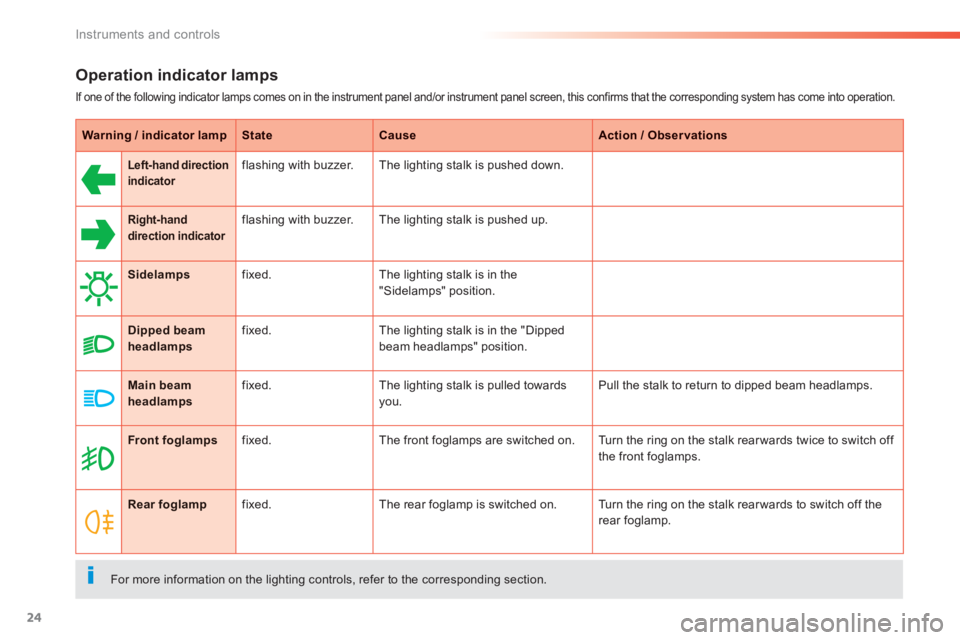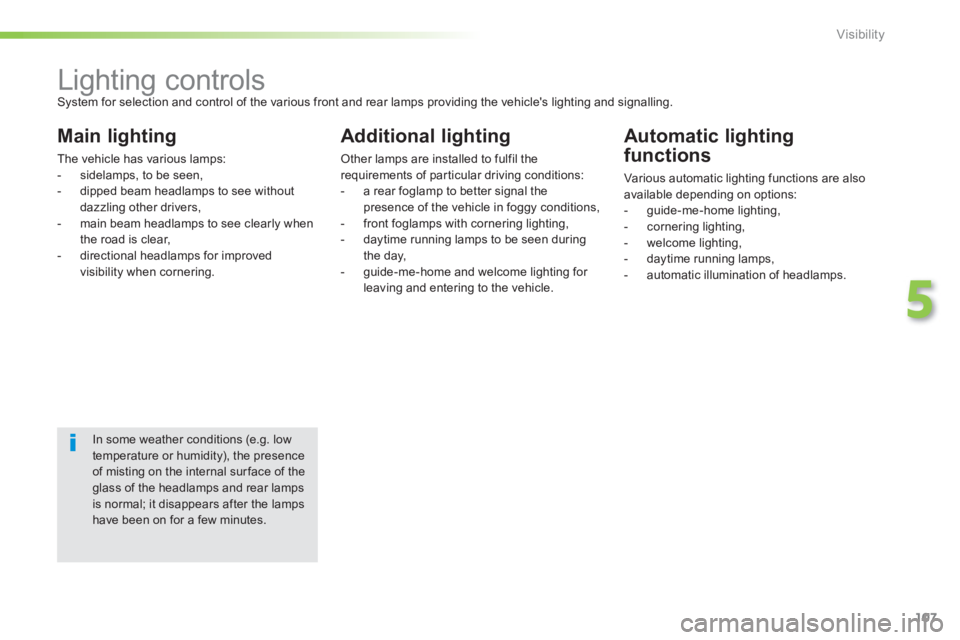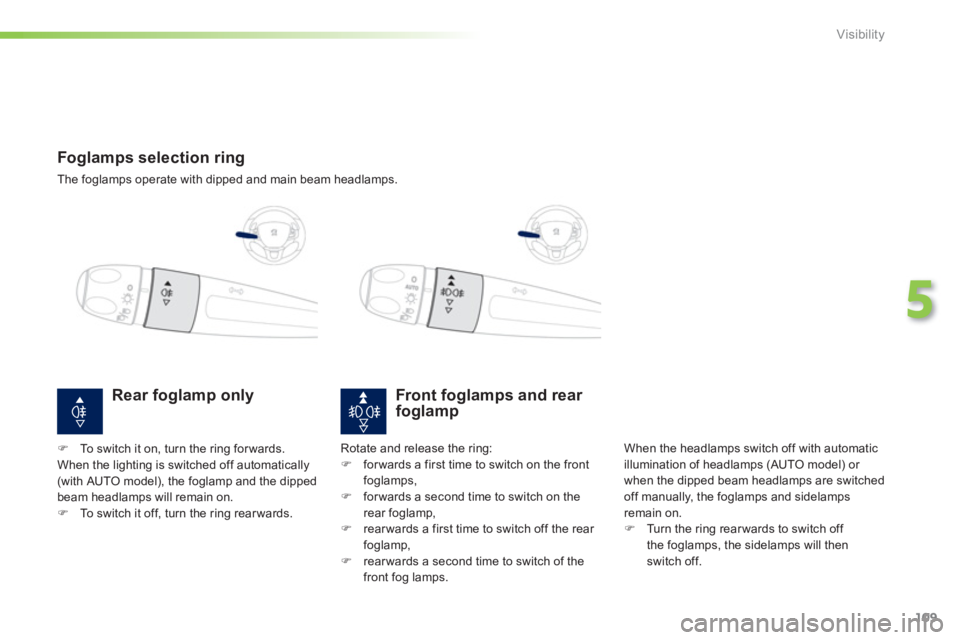2013 PEUGEOT 2008 fog light
[x] Cancel search: fog lightPage 6 of 324

4
Familiarisation
Stop & Start
This system puts the engine temporarily into standby during stops in the traffic (red lights, traffic jams, etc...). The engine restar ts automatically as soon as you want to move off. Per fectly suited to
urban use, the Stop & Start system reduces fuel consumption, exhaust emissions and thlevel when stationary.
92
Park Assist
This is an active parking system that detects a parking space then controls the steering to park
the vehicle.
10
3
Exterior
Cornering lighting
At low speed this system provides additional
lighting in corners, at junctions, when parking..., making use of the corresponding front foglamp.
115
Page 15 of 324

.
13
Familiarisation
Seeing clearly
Lighting
Ring A
Ring B
Wipers
109
Control stalk A: windscreen wipers
2.
Fast wipe. 1.Normal wipe.
Int.Intermittent wipe.0.Park.AUTO. Automatic wiping.
116
Switching on "AUTO" mode
�)
Briefly push the stalk downwards.
Switching off "AUTO" mode
�)
Briefly push the stalk downwards or place
the stalk in another position:Int, 1or 2.
Ring B: rear wiper
118
117
Lighting off.
Automatic illumination of headlamps.
Sidelamps.
Dipped / main beam headlamps.
Rear
foglamp.
Park.
Intermittent wipe.
Screenwash.
or
Front and rear
foglamps.
Single wipe: Brief pull on the stalk
towards.
Screenwash: Long pull on stalk
towards you.
Page 21 of 324

.
19
Familiarisation
Eco-driving
Eco-driving is a range of everyday practices that allow the motorist to optimise their fuel consumption and CO2emissions.
Optimise the use of your gearbox
With a manual gearbox, move off gently, change up without waiting and drive by changing up quite soon. If your vehicle has the system,
the gear shift indicator invites you to change up; it is displayed in the instrument panel, follow its instructions.
With an automatic or electronic gearbox, stay in Drive "D"or Auto "A"
, according to the type of gearbox, without pressing the accelerator pedal heavily or suddenly.
Drive smoothly
Maintain a safe distance between vehicles, use engine braking rather than the brake pedal, and press the accelerator progressively. These practices contribute towards a reduction in fuel consumption andCO2emissions and also helps reduce the background traffic noise.
If your vehicle has cruise control, make use of the system at speeds above 25 mph (40 km/h) when the traffic is flowing well.
Control the use of your electrical
equipment
Before moving off, if the passenger compar tment is too warm, ventilate it by opening the windows and air vents before using the air conditioning.
Above 30 mph (50 km/h), close the windows and leave the air vents open.
Remember to make use of equipment that can help keep thetemperature in the passenger compar tment down (sunroof and windowblinds...).
Switch off the air conditioning, unless it has automatic digital regulation, as soon as the desired temperature is attained.
Switch off the demisting and defrosting controls, if not automatic. Switch off the heated seat as soon as possible.
Switch off the headlamps and front foglamps when the level of light does not require their use.
Avoid running the engine before moving off, particularly in winter; your vehicle will warm up much faster while driving.
As a passenger, if you avoid connecting your multimedia devices (film, music, video game...), you will contribute towards limiting theconsumption of electrical energy, and so of fuel.
Disconnect your por table devices before leaving the vehicle.
Page 26 of 324

24
Instruments and controls
Operation indicator lamps
If one of the following indicator lamps comes on in the instrument panel and/or instrument panel screen, this confirms that the corresponding system has come into operation.
Warning / indicator lampStateCauseAction / Observations
Left-hand directionindicatorflashing with buzzer. The lighting stalk is pushed down.
Right-hand direction indicatorrflashing with buzzer. The lighting stalk is pushed up.
Sidelampsfixed.The lighting stalk is in the
"Sidelamps" position.
Dipped beamheadlampsfixed.The lighting stalk is in the "Dipped
beam headlamps" position.
Main beam headlampsfixed.The lighting stalk is pulled towards
you. Pull the stalk to return to dipped beam headlamps.
Front foglampsfixed.The front foglamps are switched on. Turn the ring on the stalk rear wards twice to switch off
the front foglamps.
Rear foglampfixed.The rear foglamp is switched on. Turn the ring on the stalk rear wards to switch off the
rear foglamp.
For more information on the lighting controls, refer to the corresponding section.
Page 109 of 324

107
5
Visibility
Lighting controls System for selection and control of the various front and rear lamps providing the vehicle's lighting and signalling.
Main lighting
The vehicle has various lamps:
- sidelamps, to be seen,
- dipped beam headlamps to see without
dazzlin
g other drivers,
- main beam headlamps to see clearly when
the road is clear,
- directional headlamps for improved
visibility when cornering.
Additional lighting
Other lamps are installed to fulfil therequirements of particular driving conditions:
- a rear foglamp to better signal the
presence of the vehicle in foggy conditions,
- front foglamps with cornering lighting,
- daytime running lamps to be seen duringthe day,
- guide-me-home and welcome lighting for leaving and entering to the vehicle.
Automatic lighting
functions
Various automatic lighting functions are also
available depending on options:
- guide-me-home lighting,
- cornering lighting,
- welcome lighting,
- daytime running lamps,
- automatic illumination o
f headlamps.
In some weather conditions (e.g. low temperature or humidity), the presence of misting on the internal sur face of theglass of the headlamps and rear lampsis normal; it disappears after the lamps have been on for a few minutes.
Page 111 of 324

109
5
Visibility
Foglamps selection ring
The foglamps operate with dipped and main beam headlamps.
Front foglamps and rear
foglamp
When the headlamps switch off with automatic
illumination of headlamps (AUTO model) or
when the dipped beam headlamps are switched
off manually, the foglamps and sidelamps
remain on. �) Turn the ring rear wards to switch off
the foglamps, the sidelamps will then switch off.
Rotate and release the rin
g:�) forwards a first time to switch on the front
foglamps,�) forwards a second time to switch on the rear foglamp,�)
rearwards a first time to switch off the rear foglamp,�)
rearwards a second time to switch of thefront fog lamps.
Rear foglamp only
�)To switch it on, turn the ring forwards.
When the lighting is switched off automatically (with AUTO model), the foglamp and the dipped
beam headlamps will remain on.
�)To switch it off, turn the ring rearwards.
Page 112 of 324

110
Visibility
In good or rainy weather, both day and night, the front foglamps and the rear foglamp are prohibited. In thesesituations, the power of their beams may dazzle other drivers. They shouldonly be used in fog or snow. In these weather conditions, it is your responsibility to switch on the foglamps and dipped beam headlamps manuallyas the sunshine sensor may detect sufficient light.
Do not forget to switch off the frontfoglamps and the rear foglamp when they are no longer necessary.
Switching on the lampsafter the ignition isswitched off
To reactivate the lighting control, rotate the ring to the "0"position - lamps off, then to the desired position. On opening the driver's door atemporary audible signal warns thedriver that the lighting is on.
The lamps, with the exception of thesidelamps, switch off automatically after a maximum duration of thir ty minutes to prevent discharging of the battery.
Switching off the lampswhen the ignition is switched off
On switching off the ignition, all of thelamps turn off immediately, except for dipped beam if guide-me-home lighting is activated.
Page 115 of 324

113
5
Visibility
The sidelamps and dipped beam headlamps are
switched on automatically, without any action
on the part of the driver, when a low level of external light is detected or in certain cases of
activation of the windscreen wipers.
As soon as the brightness returns to a sufficient
level or after the windscreen wipers are switched
o
ff, the lamps are switched off automatically.
Automatic illumination of
headlam
ps
Switching on
�)Turn the ring to the "AUTO"position. Activation of the function is accompanied
by a message in the screen.
Switching off
�)Turn the ring to another position.
Deactivation of the function is accompanied by a message in the screen.
Automatic guide-me-home lighting
Association with the automatic lighting provides
the guide-me-home lighting with the followingadditional options:
- selection of the lighting duration of 15,
30 or 60 seconds,
- automatic activation o
f guide-me-home lighting when the automatic illumination of
headlamps is in operation.
Operating fault
In the event of a fault with the
sunshine sensor, the lighting comes on, this warning lamp
is displayed in the instrument panel and/or a
message appears in the screen, accompaniedby an audible signal.
Contact a PEUGEOT dealer or a qualified
workshop.
In fog or snow, the sunshine sensor maydetect sufficient light. In this case, the lighting will not come on automatically. Do not cover the sunshine sensor,coupled with the rain sensor and located in the centre of the windscreenbehind the rear view mirror; theassociated functions would no longer be controlled.
Programming
The duration of the guide-me-home
lighting can be set in the vehicleconfiguration menu.